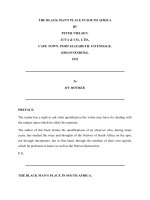Man''s Place in the Universe
Bạn đang xem bản rút gọn của tài liệu. Xem và tải ngay bản đầy đủ của tài liệu tại đây (32.63 MB, 358 trang )
s Place
Universe
Russel
Wallace
EX
LIBRIS.
Bertram
&
JtMAN
S
PLACE
IN
THE
UNIVERSEMAN S
PLACE
IN
THE
UNIVERSE
A
Study
of
the
Results
of
Scientific
Research
in
Relation
to
the
Unity
or
Plurality
of
Worlds
BY
ALFRED
R.
WALLACE
LL.D.,
D.C.L.,
F.R.S.,
ETC.
O,
glittering
host
!
O,
golden
line !
I
would I
had an
angel
s
ken,
Your
deepest
secrets
to
divine,
And
read
your
mysteries
to
men.
1
THIRD
EDITION"
LONDON
CHAPMAN
AND
HALL
LIMITED
1904
I
said unto
my
inmost
heart,
Shall I don
corslet,
helm,
and
shield,
And shall
I
with a
Giant
strive,
And
charge
a
Dragon
on the
field ?
J.
H.
DELL.
JUN
3
1958
PREFACE
THIS
work
has
been
written
in
consequence
of
the
great
interest excited
by my
article,
under the same
title,
which
appeared
simultaneously
in The Fort
nightly
Review and the New York
Independent.
Two friends who read
the
manuscript
were of
opinion
that
a
volume,
in
which
the
evidence
could
be
given
much more
fully,
would
be
desirable,
and
the result of
the
publication
of
the
article confirmed
their
view.
I
was led to
a
study
of the
subject
when
writing
four
new
chapters
on
Astronomy
for
a new edition
of
The
Wonderful
Century.
I
then
found that
almost all
writers
on
general
astronomy,
from Sir
John
Herschel to Professor Simon Newcomb and
Sir Norman
Lockyer,
stated,
as
an
indisputable
fact,
that
our sun is
situated
in
the
plane
of the
great
ring
of the
Milky
Way,
and also
very nearly
in
the
centre
of that
ring.
The
most recent researches also
showed that
there was
little
or no
proof
of
there
being
any
stars or nebulae
very
far
beyond
the
Milky Way,
which thus
seemed
to be the
limit,
in
that
direction,
of the stellar
universe.
vi
MAN
S
PLACE
IN THE
UNIVERSE
Turning
to
the earth and the other
planets
of
the
Solar
System,
I
found
that
the
most recent
re
searches
led
to
the
conclusion that
no
other
planet
was
likely
to
be
the seat of
organic
life,
unless
perhaps
of
a
very
low
type.
For
many
years
I had
paid
special
attention
to
the
problem
of the
measure
ment
of
geological
time,
and
also that
of the mild
climates and
generally
uniform
conditions that
had
prevailed throughout
all
geological epochs;
and
on
considering
the number of
concurrent
causes
and
the
delicate balance of
conditions
required
to main
tain
such
uniformity,
I
became still more convinced
that the evidence
was
exceedingly
strong against
the
probability
or
possibility
of
any
other
planet
being
inhabited.
Having long
been
acquainted
with
most
of the
works
dealing
with
the
question
of the
supposed
Plurality
of
Worlds,
I was
quite
aware of
the
very
superficial
treatment
the
subject
had
received,
even
in the
hands
of the
most
able
writers,
and this made
me
the
more
willing
to
set
forth
the
whole
of the
available
evidence
astronomical,
physical,
and
biological
in
such
a
way
as
to
show both
what
was
proved
and
what
suggested
by
it.
The
present
work
is
the
result,
and
I venture
to
think that
those
who will
read
it
carefully
will admit
that it is a
book that
was
worth
writing.
It is founded
almost
entirely
on
the
marvellous
body
of
facts
and
PREFACE
vii
conclusions
of the
New
Astronomy
together
with
those
reached
by
modern
physicists,
chemists,
and
biolo
gists.
Its
novelty
consists
in
combining
the various
results
of
these different
branches of science
into
a
connected
whole,
so as
to
show
their
bearing upon
a
single
problem
a
problem
which
is
of
very
great
interest to ourselves.
This
problem
is,
whether
or no
the
logical
inferences
to be
drawn
from
the various
results
of
modern science
lend
support
to the view
that
our
earth is
the
only
inhabited
planet,
not
only
in
the
Solar
System
but
in
the
whole stellar
universe.
Of
course
it
is a
point
as to
which
absolute
demon
stration,
one
way
or
the
other,
is
impossible.
But
in
the
absence of
any
direct
proofs,
it is
clearly
rational
to
inquire
into
probabilities
;
and
these
probabilities
must
be determined not
by
our
pre
possessions
for
any
particular
view,
but
by
an
absolutely impartial
and
unprejudiced
examination
of
the
tendency
of the
evidence.
As the book is
written for the
general,
educated
body
of
readers,
many
of
whom
may
not
be
acquainted
with
any
aspect
of
the
subject
or
with
the
wonderful advance
of
recent
knowledge
in
that
department
often
termed
the New
Astronomy,
a
popular
account
has
been
given
of
all
those
branches
of it which
bear
upon
the
special
subject
here
discussed, This
part
of
the work
occupies
the
first
viii
MAN
S PLACE
IN
THE
UNIVERSE
six
chapters.
Those who
are
fairly acquainted
with
modern astronomical
literature,
as
given
in
popular
works,
may begin
at
my
seventh
chapter,
which marks
the commencement of the
considerable
body
of evidence
and
of
argument
I have
been
able
to
adduce.
To those of
my
readers
who
may
have
been
influenced
by any
of the
adverse
criticisms
on
my
views as set forth in the
article
already
referred
to,
I must
again
urge,
that
throughout
the whole of
this
work,
neither
the
facts
nor
the more
obvious
con
clusions
from
the
facts
are
given
on
my
own
authority,
but
always
on
that
of the best
astronomers,
mathematicians,
and
other
men
of
science to
whose
works
I
have
had
access,
and
whose
names,
with
exact
references,
I
generally
give.
What I
claim
to have done
is,
to
have
brought
together
the
various facts and
phenomena
they
have
accumulated
;
to have
set forth
the
hypotheses
by
which
they
account
for
them,
or the
results to
which
the
evidence
clearly points
;
to
have
judged
between
conflicting
opinions
and
theories
;
and
lastly,
to
have
combined
the
results of
the
various
widely-separated
departments
of
science,
and to
have
shown how
they
bear
upon
the
great problem
which
I
have
here
endeavoured,
in
some
slight
degree,
to
elucidate.
As
such
a
large
body
of
facts
and
arguments
from
PREFACE
ix
distinct
sciences
have been
here
brought together,
I
have
given
a rather
full
summary
of
the
whole
argument,
and
have
stated
my
final conclusions in
six short sentences.
I
then
briefly
discuss
the two
aspects
of
the
whole
problem
those from
the
materialistic
and
from the
spiritualistic
points
of
view
;
and
I
conclude
with a few
general
observations
on
the
almost
unthinkable
problems
raised
by
ideas
of
Infinity- -problems
which some
of
my
critics
thought
I had
attempted
in
some
degree
to
deal
with,
but
which,
I
here
point
out,
are
altogether
above
and
beyond
the
questions
I
have
discussed,
and
equally
above
and
beyond
the
highest
powers
of the
human
intellect.
BROADSTONE,
DORSET,
September
1903.
The
wilder d
mind
is
tost
and
lost,
O
sea,
in
thy
eternal
tide
;
The
reeling
brain
essays
in
vain,
O
stars,
to
grasp
the
vastness
wide !
The
terrible
tremendous
scheme
That
glimmers
in
each
glancing
light,
O
night,
O
stars,
too
rudely
jars
The
finite
with the
infinite !
J.
H.
DELL
CONTENTS
CHAP.
PAGE
I.
EARLY
IDEAS,
.
.
I
II.
MODERN
IDEAS,
.
7
III.
THE
NEW
ASTRONOMY,
.
.
.24
IV.
THE
DISTRIBUTION
OF
THE
STARS,
. .
47
V.
DISTANCES
OF
STARS:
THE SUN
S
MOTION,
.
73
VI. UNITY
AND
EVOLUTION
OF
THE
STAR-SYSTEM,
.
99
VII.
ARE
THE STARS
INFINITE?.
.
.
135
VIII. OUR
RELATION
TO
THE
MILKY
WAY,
.
156
IX.
THE
UNIFORMITY
OF
MATTER
AND
ITS
LAWS,
183
X.
THE ESSENTIAL
CHARACTERS
OF ORGANISMS
191
XL
PHYSICAL
CONDITIONS
ESSENTIAL
FOR
LIFE,
206
XII.
THE
EARTH
IN
RELATION
TO
LIFE,
218
"
XIII.
THE
ATMOSPHERE
IN RELATION
TO
LIFE,
.
.
243
XIV.
THE
OTHER
PLANETS
ARE
NOT
HABITABLE,
.
262
XV.
THE
STARS
: HAVE
THEY
PLANETS
? ARE
THEY
USEFUL
TO
Us
?
.
.
.
282
XVI.
STABILITY
OF
THE
STAR-SYSTEM
:
IMPORTANCE
OF
CENTRAL
POSITION
:
SUMMARY
AND
CONCLUSION,
295
S
INDEX,
.
EIGHT
DIAGRAMS
IN THE
TEXT AND
TWO
STAR
CHARTS
AT
END.
Who
is
man,
and
what
his
place?
Anxious
asks
the
heart,
perplext
In
this
recklessness
of
space,
Worlds
with
worlds
thus
intermixt :
What
has
he,
this
atom
creature,
In
the
infinitude
of
Nature ?
F.
T.
PALGRAVE.
MAN S
PLACE
IN
THE
UNIVERSE
CHAPTER
I
EARLY
IDEAS
AS
TO
THE
UNIVERSE AND
ITS
RELATION
TO
MAN
WHEN men
attained
to
sufficient
intelligence
for
speculations
as
to
their
own
nature
and
that of
the
earth
on
which
they
lived,
they
must have
been
pro
foundly
impressed
by
the
nightly pageant
of
the
starry
heavens.
The
intense
sparkling brilliancy
of
Sirius and
Vega,
the
more massive
and
steady
lumin
osity
of
Jupiter
and
Venus,
the
strange
grouping
of
the
brighter
stars into constellations to
which
fantastic
names
indicating
their
resemblance
to various
animals
or
terrestrial
objects
seemed
appropriate
and
were
soon
generally
adopted,
together
with the
apparently
innumerable stars of
less and
less
brilliancy
scattered
broadcast
over the
sky,
many only
being
visible
on
the
clearest
nights
and
to the
acutest
vision,
consti
tuted
altogether
a
scene of
marvellous
and
impressive
splendour
of which
it
must
have seemed almost im
possible
to attain
any
real
knowledge,
but which
afforded an
endless
field
for the
imagination
of the
observer.
The relation
of the
stars
to the
sun and
moon in
their
respective
motions
was
one
of
the
earliest
pro-
4
2
MAN
S
PLACE IN
THE
UNIVERSE
[CHAP.
blems
for
the
astronomer,
and
it
was
only
solved
by
careful and
continuous
observation,
which
showed
that
the
invisibility
of
the
former
during
the
day
was
wholly
due to
the
blaze
of
light,
and
this is
said
to
have been
proved
at
an
early
period
by
the
observed
fact
that
from the
bottom of
very deep
wells
stars
can
be seen
while the
sun is
shining.
During
total
eclipses
of the
sun also the
brighter
stars
become
visible,
and,
taken
in connection with
the
fixity
of
position
of
the
pole-star,
and the
course of
those
circumpolar
stars
which never
set
in
the latitudes of
Greece,
Egypt,
and
Chaldea,
it soon
became
possible
to frame
a
simple hypothesis
which
supposed
the
earth
to
be
suspended
in
space,
while at an
unknown
distance
from it
a
crystal
sphere
revolved
upon
an
axis
indicated
by
the
pole-star,
and carried with
it
the
whole host of
heavenly
bodies.
This was
the
theory
of
Anaximander
(540 B.C.),
and it
served
as
the
starting-point
for the
more
complex theory
which continued
to
be held in various
forms
and
with endless
modifications
down to
the end of
the
sixteenth
century.
It is
believed
that the
early
Greeks obtained
some
knowledge
of
astronomy
from
the
Chaldeans,
who
appear
to
have
been the
first
systematic
observers of
the
heavenly
bodies
by
means of
instruments,
and
who are
said
to
have
discovered
the
cycle
of
eighteen
years
and
ten
days
after
which the sun
and
moon
return to the
same
relative
positions
as seen
from
the earth. The
Egyptians
perhaps
derived their
knowledge
from the same
source,
but
there
is
no
proof
that
they
were
great
observers,
and the accu
rate
orientation,
proportions,
and
angles
of
the
Great
I.]
EARLY
IDEAS
3
Pyramid
and
its
inner
passages
may
perhaps
indicate
a
Chaldean
architect.
The
very
obvious
dependence
of
the
whole
life
of
the earth
upon
the
sun,
as
a
giver
of
heat
and
light,
sufficiently explains
the
origin
of the
belief
that the
latter
was
a
mere
appanage
of
the
former
;
and as
the
moon
also
illuminates
the
night,
while the
stars
as
a whole
also
give
a
very
perceptible
amount
of
light,
especially
in
the
dry
climate
and
clear
atmo
sphere
of
the
East,
and
when
compared
with the
pitchy
darkness
of
cloudy
nights
when
the
moon
is below
the
horizon,
it
seemed
clear
that
the
whole
of
these
grand
luminaries
sun,
moon, stars,
and
planets
were
but
parts
of
the
terrestrial
system,
and existed
solely
for the
benefit
of
its
inhabitants.
Empedocles
(444
B.C.)
is said
to
have been the
first who
separated
the
planets
from
the
fixed
stars,
by observing
their
very peculiar
motions,
while
Pythagoras
and
his followers
determined
correctly
the order of their
succession
from
Mercury
to Saturn.
No
attempt
was made
to
explain
these
motions till
a
century
later,
when
Eudoxus
of
Cnidos,
a
con
temporary
of Plato
and
of
Aristotle,
resided
for
some
time
in
Egypt,
where he
became a
skilful
astronomer.
He
was
the first who
systematically
worked
out and
explained
the various
motions
of the
heavenly
bodies
on the
theory
of circular and
uniform
motion round
the
earth
as a
centre,
by
means
of
a series
of
con
centric
spheres,
each
revolving
at
a
different rate
and
on
a
different
axis,
but so
united
that
all shared
in
the motion
round the
polar
axis.
The
moon,
for
example,
was
supposed
to be carried
by
three
spheres,
che first
revolved
parallel
to
the
equator
4
MAN S
PLACE
IN
THE
UNIVERSE
[CHAP.
and
accounted
for
the
diurnal motion-
-the
rising
and
setting-
-of
the
moon
;
another moved
parallel
to
the
ecliptic
and
explained
the
monthly
changes
of
the
moon
;
while
the
third
revolved
at
the same rate
but
more
obliquely,
and
explained
the inclination of
the
moon
s orbit
to
that
of
the
earth. In
the same
way
each
of
the
five
planets
had
four
spheres,
two
moving
like
the
first two
of
the
moon,
another one
also
moving
in
the
ecliptic
was
required
to
explain
the
retrograde
motion
of the
planets,
while
a fourth
oblique
to
the
ecliptic
was
needed to
explain
the
diverging
motions
due
to
the
different
obliquity
of
the orbit
of
each
planet
to
that of
the earth.
This
was the celebrated
Ptolemaic
system
in
the
simplest
form needed
to
account
for
the more obvious motions
of the
heavenly
bodies.
But
in
the course
of
ages
the
Greek
and Arabian
astronomical
observers
discovered
small
divergences
due
to the
various
degrees
of
excentricity
of the
orbits
of
the
moon
and
planets
and
their
consequent
varying
rates of motion
;
and
to
explain
these
other
spheres
were
added,
together
with smaller
circles sometimes
revolving
excentri-
cally,
so that at
length
about
sixty
of
these
spheres,
epicycles
and
excentrics
were
required
to account
for
the various
motions observed
with
the rude
instruments,
and
the
rates of
motion
determined
by
the
very
imperfect
time -measurers
of those
early
ages.
And
although
a few
great philosophers
had
at different
times
rejected
this
cumbrous
system
and
had endeavoured to
promulgate
more
correct
ideas,
their
views
had
no
influence
on
public opinion
even
among
astronomers
and
mathematicians,
and the
Ptolemaic
system
held
full
sway
down
to
the
time
of
I.]
EARLY IDEAS
5
Copernicus,
and
was not
finally
given
up
till
Kepler
s
Laws
and Galileo
s
Dialogues compelled
the
adoption
of
simpler
and
more
intelligible
theories.
We are
now
so accustomed
to look
upon
the main
facts
of
astronomy
as
mere
elementary knowledge
that
it
is
difficult
for
us
to
picture
to
ourselves the
state of
almost
complete ignorance
which
prevailed
even
among
the most
civilised
nations
throughout
antiquity
and
the Middle
Ages.
The
rotundity
of the
earth was
held
by
a few at
a
very
early period,
and
was
fairly
well
established
in later classical times.
The
rough
determination
of
the
size
of our
globe
followed soon
after
;
and
when
instrumental
observa
tions
became
more
perfect,
the
distance
and
size
of
the moon
were measured
with sufficient
accuracy
to
show that
it was
very
much smaller
than the earth.
But
this
was
the
farthest
limit of
the determination
of astronomical sizes
and
distances
before
the dis
covery
of
the
telescope.
Of
the
sun
s real distance
and
size
nothing
was
known
except
that
it
was
much
farther from
us
and
much
larger
than the
moon
;
but
even
in
the
century
before the
commencement
of
the
Christian era
Posidonius
determined
the
circumference
of the earth to be
240,000
stadia,
equal
to about
28,600
miles,
a
wonderfully
close
approximation
considering
the
very
imperfect
data
at his command.
He
is
also
said to
have calculated the sun
s
distance,
making
it
only
one-third less
than the
true
amount,
but this
must
have
been a chance
coincidence,
since he
had
no
means
of
measuring
angles
more
accurately
than
to one
degree,
whereas in
the
determination
of
the
sun
s distance
instruments
are
required
which measure
to
a
second
of
arc.
6
MAN
S
PLACE
IN THE
UNIVERSE
[CHAP.
i.
Before
the
discovery
of the
telescope
the sizes
of
the
planets
were
quite
unknown,
while the most
that
could
be ascertained
about
the
stars
was,
that
they
were
at
a
very
great
distance
from us. This
being
the
extent
of
the
knowledge
of the
ancients as to the
actual
dimensions
and constitution
of the visible uni
verse,
of
which,
be it
remembered,
the
earth was
held
to be
the
centre,
we cannot be
surprised
at the
almost
universal
belief
that
this
universe
existed
solely
for
the
earth and
its inhabitants.
In
classical times it
was
held
to be
at once the
dwelling-place
of the
gods
and
their
gift
to
man,
while
in
Christian
ages
this belief
was
but
slightly,
if
at
all,
changed
;
and
in
both
it
would have
been considered
impious
to
main
tain that
the
planets
and stars
did
not
exist for the
service
and
delight
of
mankind alone but
in
all
pro
bability
had their
own
inhabitants,
who
might
in
some
cases be even
superior
in
intellect to
man him
self.
But
apparently,
during
the
whole
period
of
which
we
are
now
treating,
no
one
was
so
daring
as
even
to
suggest
that there
were other
worlds with
other
inhabitants,
and
it was
no
doubt because of the
idea that we
occupied
the
world,
the
very
centre of
the whole
surrounding
universe
which
existed
solely
for
us,
that the discoveries of
Copernicus,
Tycho
Brahe,
Kepler,
and
Galileo
excited
so
much anta
gonism
and were held
to be
impious
and
altogether
incredible.
They
seemed to
upset
the whole
accepted
order of
nature,
and
to
degrade
man
by
removing
his
dwelling-place,
the
earth,
from
the
commanding
cen
tral
position
it
had
always
before
occupied.
CHAPTER
II
MODERN
IDEAS AS
TO
MAN*S RELATION
TO
THE UNIVERSE
THE
beliefs
as to
the
subordinate
position
held
by
sun, moon,
and stars in
relation
to the
earth,
which
were almost universal
down
to
the time of
Coper
nicus,
began
to
give
way
when
the discoveries
of
Kepler
and
the revelations of
the
telescope
demon
strated
that
our earth was
not
specially
distinguished
from
the other
planets by
any
superiority
of
size
or
position.
The
idea at
once
arose
that the other
planets
might
be inhabited
;
and when
the
rapidly
increasing
power
of
the
telescope,
and of astronomical
instruments
generally,
revealed
the wonders of
the
solar
system
and the
ever-increasing
numbers of the
fixed
stars,
the belief in
other
inhabited worlds
became
as
general
as
the
opposite
belief
had
been
in
all
preceding
ages,
and it is still
held
in modified
forms to
the
present day.
But
it
may
be
truly
said
that
the later
like
the
earlier belief
is
founded
more
upon religious
ideas
than
upon
a
scientific and
careful
examination
of
the
whole of
the
facts
both
astronomical,
physical,
and
biological,
and
we must
agree
with the
late Dr.
Whewell,
that
the
belief that
other
planets
are
inhabited has been
generally
entertained,
not
in con
sequence
of
physical
reasons
but
in
spite
of
them.
8
MAN S
PLACE
IN
THE
UNIVERSE
[CHAP.
And
he
adds
: It was
held
that
Venus,
or
that
Saturn was
inhabited,
not because
any
one
could
devise,
with
any
degree
of
probability,
any
organised
structure
which would be
suitable to animal
existence
on
the
surfaces of those
planets
;
but
because
it was
conceived that the
greatness
or
goodness
of
the
Creator,
or His
wisdom,
or
some
other of His
attri
butes,
would
be
manifestly imperfect,
if
these
planets
were not tenanted
by
living
creatures.
Those
persons
who have
only
heard that
many
eminent
astronomers
down to
our own
day
have
upheld
the
belief
in a
Plurality
of
Worlds will
naturally
suppose
that
there
must be
some
very
cogent
argu
ments
in
its
favour,
and that
it
must be
supported by
a
considerable
body
of more or
less
conclusive facts.
They
will
therefore
probably
be
surprised
to hear
that
any
direct evidence
which
may
be held to
support
the view is almost
wholly wanting,
and that
the
greater part
of
the
arguments
are
weak and
flimsy
in
the
extreme.
Of
late
years,
it
is
true,
some
few writers have
ventured to
point
out
how
many
difficulties
there are
in
the
way
of
accepting
the
belief,
but even these
have never
examined
the
question
from
the
various
points
of
view
which are
essential
to
a
proper
consideration of it
;
while,
so
far
as
it is still
upheld,
it is
thought
sufficient to
show,
that
in
the
case of
some of
the
planets,
there
seem to be
such condi
tions as
to
render
life
possible.
In
the
millions
of
planetary systems
supposed
to
exist
it is held
to
be
incredible
that
there are
not
great
numbers
as well
fitted
to
be
inhabited
by
animals
of all
grades,
including
some as
high
as
man
or even
higher,
and
II.]
MODERN
IDEAS
9
that
we
must, therefore,
believe that
they
are
so
inhabited.
As
in the
present
work
I
propose
to
show,
that
the
probabilities
and the
weight
of
direct
evidence
tend
to
an
exactly
opposite
conclusion,
it
will
be
well to
pass
briefly
in
review the
various
writers on
the
subject,
and
to
give
some
indication of
the
arguments
they
have
used
and
the
facts
they
have
set
forth. For
the earlier
upholders
of the
theory
I am indebted
to Dr.
Whewell,
who,
in his
Dialogue
on
the
Plurality
of
Worlds a
Supplement
to
his well-known
volume
on
the
subject
refers to
all
writers
of
importance
known
to
him.
The
earliest
are the
great
astronomers
Kepler
and
Huygens,
and
the learned
Bishop
Wilkins,
who all
believed
that
the
moon
was or
might
probably
be
inhabited
;
and
of
these Whewell
considers
Wilkins
to
have been
by
far the
most
thoughtful
and
earnest
in
supporting
his
views.
Then
we have Sir
Isaac
Newton himself
who,
at considerable
length,
argued
that
the
sun was
probably
inhabited. But
the
first
regular
work
devoted to the
subject
appears
to
have
been
written
by
M.
Fontenelle,
Secretary
to
the
Academy
of Sciences
in
Paris,
who
in 1686
published
his
Conversations
on
the
Plurality of
Worlds.
The
book
consisted
of five
chapters,
the first
explaining
the
Copernican
Theory
;
the second
maintaining
that
the
moon is
a
habitable
world
;
the third
gives
particulars
as to
the
moon,
and
argues
that
the
other
planets
are
also inhabited
;
the fourth
gives
details
as
to the worlds
of
the five
planets
;
while
the
fifth
declares that
the fixed
stars are
suns,
and
that
each
illuminates a
world. This
work
was
so well
written,
and
the
subject proved
so
attractive,
that it was









